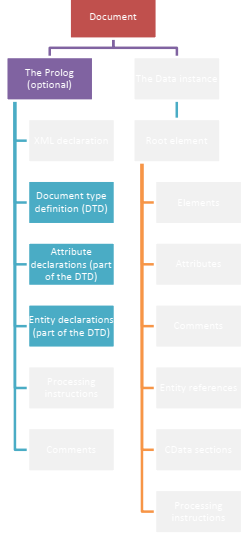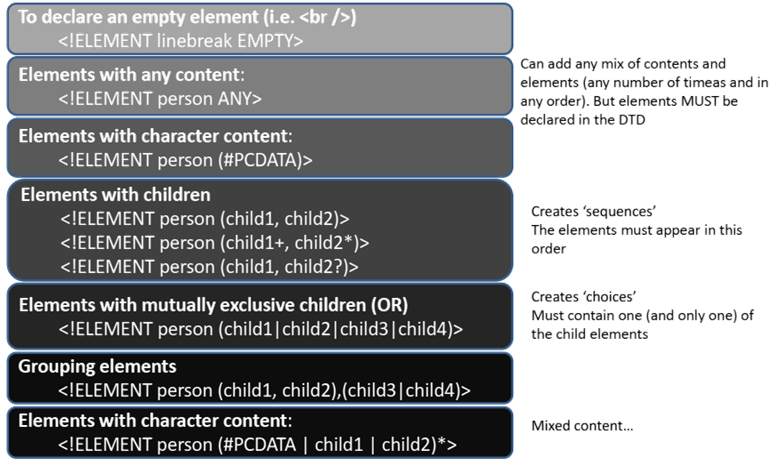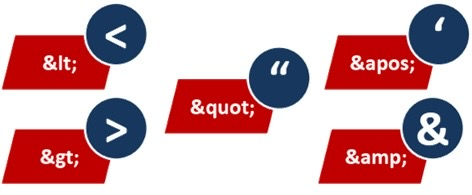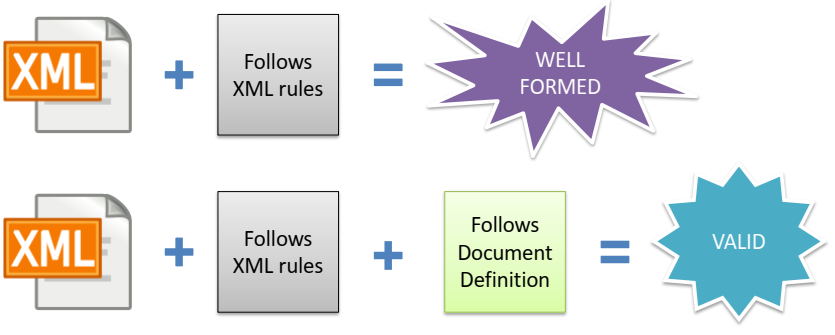Week 2 - XML Schema and DTD
Table of content
- Review Week 1 Tutorial.
- Review XML structure.
- Review XML rules.
- Explain what an XML schema is.
- Explain what a document definition is.
- Create a DTD document definition.
- Understand the main elements of DTD.
XML Schema?
- The schema describes the structure.
- What data is allowed.
- What data is required.
- How data is organized.
- Example: maged#zy.cdut
Well Formed and Valid XML
XML document is well-formed:
- structurally and syntactically correct.
- Adheres to the general XML rules.
- Not necessarily valid. XML document is valid:
- Satisfies the schema document.
- Validity can vary between schema documents.
- XML documents that fail validation are considered invalid.
XML Schema Types
The XML schema has two types:
- DTD: Document Type Definition.
- XSD: XML Schema Definition.
DTDs

Document Type Definition (DTD)
DTD is a structure (standard)
- A DTD is a set of markup declarations that define the document structure.
- Uses a list of validated elements and attributes.
- What elements can/must appear.
- What order they must be in.
DTD basics
DTD determines:
- What the root element is.
- Number of instances of elements. DTD does not determine:
- Data types.
- Meaning of an element.
Is DTD also an XML file?
No, DTDs are NOT xml
DTD location
Internal: declared inside the XML document.
- Appears after the XML declaration, and before the document body. External: declared outside the XML document (as an external reference).
DOCTYPE
- internal
xml
<!DOCTYPE Name [
Document definition
]>- external
xml
<!DOCTYPE events SYSTEM "xxx.dtd">The contents of a DTD
 DTD Elements:
DTD Elements:
- Elements are the allowed/required tags.
- Created with an Element declaration.
- ElementName = XML Tag.
- Type = Tag Type
Internal DTD Example
xml
<?xml version="1.0" standalone="yes"?>
<!DOCTYPE Foods [
<!ELEMENT Foods (Food)*>
<!ELEMENT Food (Fruits,Vegetables,Meat,Fish)>
<!-- 上面的元素定义了食品的结构(Food内的标签及其顺序,即Fruits,Vegetables,Meat,Fish) -->
<!ELEMENT Fruits (#PCDATA)>
<!ELEMENT Vegetables (#PCDATA)>
<!ELEMENT Meat (#PCDATA)>
<!ELEMENT Fish (#PCDATA)>
]>
<!-- 在浏览器中查看XML文件时,DOCTYPE部分并不会显示 -->
<Foods>
<Food>
<Fruits>Apple</Fruits>
<Vegetables>Carrot</Vegetables>
<Meat>Lamb</Meat>
<Fish>Salmon</Fish>
</Food>
<Food>
<Fruits>Orange</Fruits>
<Vegetables>Cucumber</Vegetables>
<Meat>Mutton</Meat>
<Fish>Cod</Fish>
</Food>
</Foods>External DTD Example
Foods.xml
xml
<?xml version="1.0" standalone="no"?>
<!DOCTYPE Foods SYSTEM “FoodsDTD.dtd">
<Foods>
<Food>
<Fruits>Apple</Fruits>
<Vegetables>Carrot</Vegetables>
<Meat>Lamb</Meat>
<Fish>Salmon</Fish>
</Food>
<Food>
<Fruits>Orange</Fruits>
<Vegetables>Cucumber</Vegetables>
<Meat>Mutton</Meat>
<Fish>Cod</Fish>
</Food>
</Foods>FoodsDTD.dtd
xml
<!ELEMENT Foods (Food)*>
<!ELEMENT Food (Fruits,Vegetables,Meat,Fish)>
<!ELEMENT Fruits (#PCDATA)>
<!ELEMENT Vegetables (#PCDATA)>
<!ELEMENT Meat (#PCDATA)>
<!ELEMENT Fish (#PCDATA)>- Private external DTD:
<!DOCTYPE name SYSTEM “pathToFile”> - External DTD on a website:
<!DOCTYPE name SYSTEM “URL”>
Element type declarations
 Mixed content需要把#PCDATA写在最前面
Mixed content需要把#PCDATA写在最前面
- (#PCDATA): The content can be only character data.
- e.g.,
- DTD:
<!ELEMENT first (#PCDATA)> - XML:
<first> John </first>
- DTD:
- e.g.,
- EMPTY: The element is declared to be an empty one - no content allowed.
- e.g.,
- DTD:
<!ELEMENT empty_element EMPTY> - XML:
<empty_element></empty_element>or<empty_element />
- DTD:
- e.g.,
- ANY: The element can have any element or character data.
- e.g.,
- DTD:
<!ELEMENT any_element ANY> - XML:
- DTD:
- e.g.,
xml
<any_element>
This is a line of characters
<other_element> ... </other_element>
</any_element>- Child elements: The content can only contain the child elements (no character data). The sequence, alternative, and cardinality can be expressed using commas(,) Ors (|).
- e.g. DTD:
<!ELEMENT a (x,y,z)>Element a must have an element x, followed by y, followed by z. - e.g. DTD:
<!ELEMENT b (x|y|z)>Element b must have an element x, or y, or z
- e.g. DTD:
- Mixed content
- Must use OR | to separate elements
- #PCDATA must come first
- * Must appear at the end if there are child elements
- e.g., DTD:
<!ELEMENT mix_element (#PCDATA | first | last)*>
xml
<mix_element>
My first name is
<first>John</first>
and my last name is
<last>smith </last>
</mix_element>DTD Element Options (modifiers)
<!ELEMENT Foods (Food)*>- *: zero or more times.
- +: one or more times.
- ?: zero or one time.
- No symbol means the element must appear only once.
- e.g. DTD:
<!ELEMENT c (x*, y+, z?) >
DTD Element Options
Elements with children
xml
<!ELEMENT person (child1,child2)>
<!ELEMENT person (child1+,child2)>
<!ELEMENT person (child1*,child2)>
<!ELEMENT person (child1?,child2)>
<!ELEMENT person (child1|(child2,child3))*>DTD Attributes
<!ATTLIST ElementName AttributeName AttType DefaultValue>
- Some common attribute data types:
- CDATA: Character data (text values).
- ID: unique key.
- Enumerator: list of values (value1 | value2 | value3). e.g. DTD:
<!ATTLIST event cancelled (y|n) #REQUIRED>
- Some common default values:
- #REQUIRED:
<!ATTLIST Food orderNo CDATA #REQUIRED> - #IMPLIED: the attribute is optional
- “default character data”
<!ATTLIST person sex CDATA “male"> - #FIXED:
<!ATTLIST Form language CDATA #FIXED “EN”>
- #REQUIRED:
DTD Attributes Example
xml
<?xml version="1.0" standalone=“yes"?>
<!DOCTYPE Foods [
<!ELEMENT Foods (Food)*>
<!ELEMENT Food (Fruits,Vegetables,Meat,Fish)>
<!ATTLIST Food orderNo CDATA "1">
<!ELEMENT Fruits (#PCDATA)>
<!ELEMENT Vegetables (#PCDATA)>
<!ELEMENT Meat (#PCDATA)>
<!ELEMENT Fish (#PCDATA)>
]>
<Foods>
<Food orderNo ="1">
<Fruits>Apple</Fruits>
<Vegetables>Carrot</Vegetables>
<Meat>Lamb</Meat>
<Fish>Salmon</Fish>
</Food>
<Food orderNo ="2">
<Fruits>Orange</Fruits>
<Vegetables>Cucumber</Vegetables>
<Meat>Mutton</Meat>
<Fish>Cod</Fish>
</Food>
</Foods>Structure: CDATA
CDATA / PCDATA sections can be declared in both DTD and XML files
- Attributes can be defined in DTD using CDATA
- Elements can be defined in DTD using #PCDATA
- You can also declare a CDATA section directly in an XML file with the following processing instruction :
<![CDATA[<tags>content</tags>]]>
Entity declarations
To declare in DTD: <!ENTITY entityName "Long string or other character">
To display: &entityName;
Predefined entities: 
xml
<?xml version="1.0" standalone="yes"?>
<!DOCTYPE Universities [
<!ELEMENT Universities (University)*>
<!ELEMENT University (#PCDATA)>
<!ENTITY CDUT "Chengdu University of Technology">
<!ENTITY OBU "Oxford Brookes University">
]>
<Universities>
<University>&CDUT;</University>
<University>&OBU;</University>
</Universities>Result:
xml
<Universities>
<University>Chengdu University of Technology </University>
<University>Oxford Brookes University </University>
</Universities>Comments
html
<!-- comments are written in the same way as XML and HTML comments-->Issues with Document definitions
- If your document contains a link to a definition and the definition changes your document may break.
- If you link to a document definition and the link breaks your XML will not work.
Remember

XML Validation
Check the validity of your XML
- Is it well formed?
- Is it valid?
Useful Information
Once NP++ and XML tools are installed, go to: Plugins > XML Tools > Options
Set "Prohibit DTD" to FALSE. This allows the use of internal DTDs in your XML files. By default, these are disabled.